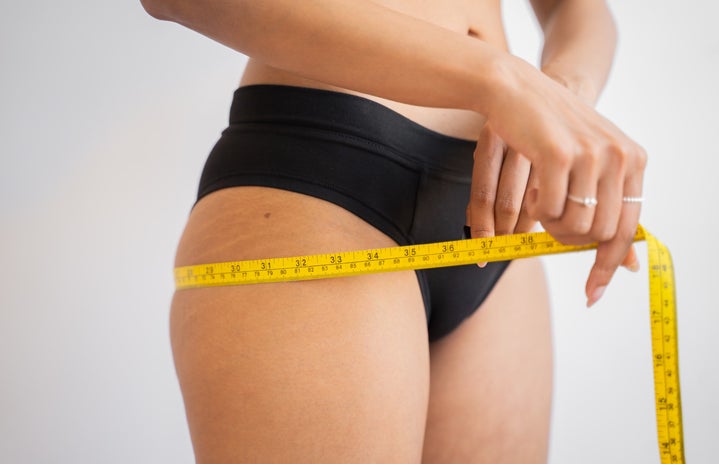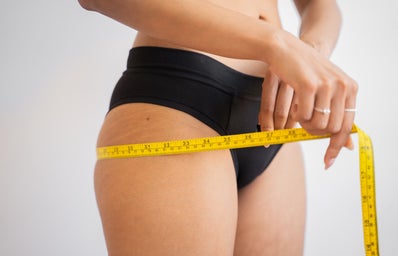“Why are men’s jeans measured in waist circumference whereas women’s jeans are measured in arbitrary, meaningless numbers?” This a question I have heard many variations of, mainly via my female and feminine-presenting friends. When someone asks me my size, I always have to explain something along the lines of, “well, at X store, I’m a 6, but at X store, I’m a 10…if it’s a tank top, I get a size small, but for dresses, I have to get a large…oh and on every third Monday of the month, my size is either an 8 or a 4… so yeah it depends.” An exaggeration, but clearly, women’s sizing isn’t an exact science. It’s not exact, nor is it a science. It’s just a bunch of numbers made up by men.
I remember shopping at Justice with my mom circa 2012 and remarking on the sizes; it goes 6, 8, 10…why does it increase by increments of 2? What happened to the odd numbers? It made no sense to me. I was further baffled when my mom dragged me to one of the “grown-up” clothing stores–the sizes, surely enough, still increased by increments of 2. But the scale started at 0, 00, or 000–not at 1? My 8-year-old takes-everything-literally brain could not even fathom what this meant; how is 00 or 000 any different than just flat-out 0?
Society encourages men to be strong, present, and take up space, whereas women are expected to be submissive, petite, and take up as little space as possible. You see the effects of this toxic socialization through differences in body language, behaviors, speech patterns, and, ultimately, cultural bodily expectations between men and women. Women with larger bodies are seen as a deviation from the hegemonic image of femininity and are ultimately shamed by society. Regarding sizing, the “norm” is set at size 0/00/000, and the further one strays from this value, the more subsequent shame and distress one feels. There is so much stigma surrounding large numbers on the sizing scale. I’m sure you remember the store 1-3-5 in the movie Mean Girls–they only carry sizes 1, 3, and 5, and when Regina asks for a bigger size, they condescendingly tell her to try Sears. Likewise, you hear women declare, “I’m trying to get down to a size 0,” and those who have attained that beauty standard flaunt it and do everything they can to remain right there.
Think about how problematic this is. Women are told to strive to be zero—to be nothing—to be accepted.
On the contrary, men’s clothing is based on actual measurements because they don’t experience the same overt objectification as women. They are allowed to be big, to take up space, to be something. If you think about sizing men’s clothing by the same standards as women’s clothing is sized, it doesn’t make sense. There’s the double standard in action.
I consider myself of average build, and yet every time I walk into a Forever 21 or any other chain clothing company directed toward young women, I find myself shopping in the large or extra-large section. If you consider the body types of all of the women in the world, I am surely not the largest on the spectrum; I’m not even close.
According to the US Department of Health and Human Services, the average size (according to the previously discussed and deeply flawed scale of even integers that women are measured by) for women in the country is 16, yet most chain stores don’t even carry that size, or if they do, it’s in a small section in the back labeled “plus-size.”
In a society that praises the traditionally thin European body type, it’s no surprise that large corporations fail to accommodate anyone who falls outside that demographic. One popular clothing brand, Brandy Melville, illustrates just that. If you don’t know the concept of their clothing line, they run on a “one size fits all principle.” They only manufacture clothing of one size and expect all of their clientele to adhere to that standard. And I bet you can guess that that size is nowhere near the average size of 16.
The company was founded by two men, Silvio Marsan and his son, Stefan Marsan, who then, without knowing anything about women’s bodies and varying body types, profited off of governing women’s bodies. They generate the idea that if you’re not part of the elite percentage that can fit into their clothing, you aren’t “good enough.” (But I promise you are; a man named Silvio can’t take that away from you!) But Brandy isn’t the only culprit here; most fast fashion brands do this exact same thing, just in a less blatant way.
The emphasis that the fashion industry puts on thinness perpetuates eating disorders and the toxic culture surrounding them. Women are conditioned from a young age to value being “skinny” over anything. Our society tells women that it’s okay to put themselves through physical and emotional turmoil to go down a size or to fit into that one dress that used to fit 10 years ago. We are told that we need to fit into clothes that were made for the small subset of thin, white, able-bodied women, and if we fail to do so, there is something wrong with us that needs to be fixed.
Saying that the fashion industry is problematic is a severe understatement. As long as contemporary fashion continues its prevailing exclusiveness and objectification through sizing, many will fall victim to the patriarchal ideals it so shamelessly promotes.


